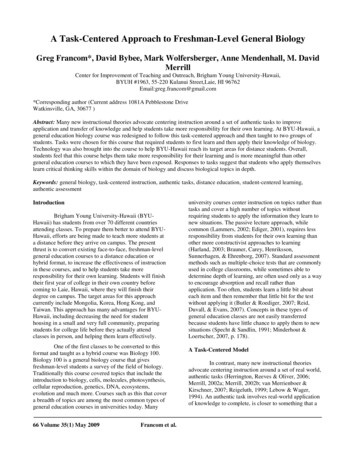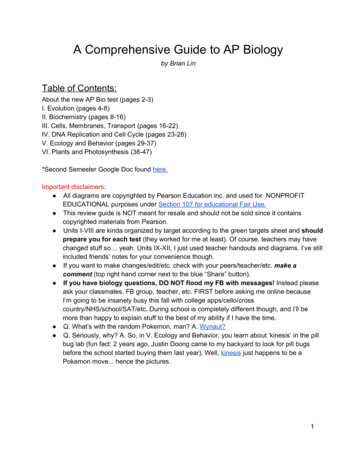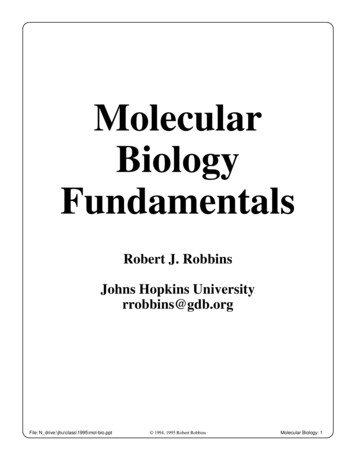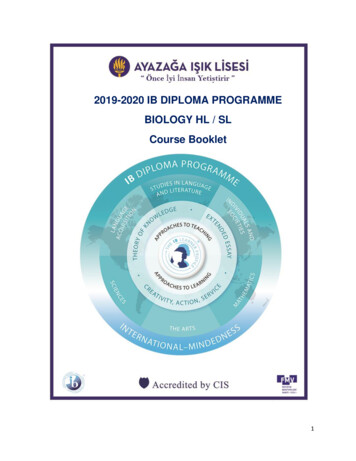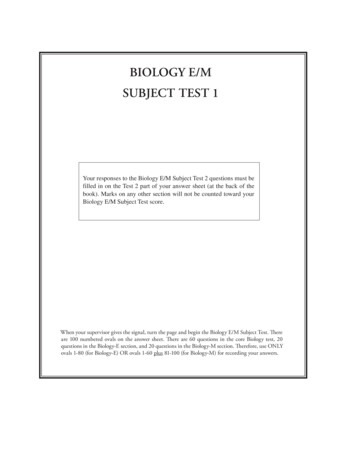
Transcription
BIOLOGY E/MSUBJECT TEST 1Your responses to the Biology E/M Subject Test 2 questions must befilled in on the Test 2 part of your answer sheet (at the back of thebook). Marks on any other section will not be counted toward yourBiology E/M Subject Test score.When your supervisor gives the signal, turn the page and begin the Biology E/M Subject Test. Thereare 100 numbered ovals on the answer sheet. There are 60 questions in the core Biology test, 20questions in the Biology-E section, and 20 questions in the Biology-M section. Therefore, use ONLYovals 1-80 (for Biology-E) OR ovals 1-60 plus 81-100 (for Biology-M) for recording your answers.Cracking SAT Bio 21 Ch 16 1314 111612 DAS.indd 39611/16/2012 3:53:40 PM
BIOLOGY E/M SUBJECT TEST 1—ContinuedFOR BOTH BIOLOGY-E AND BIOLOGY-M,ANSWER QUESTIONS 1-60Directions: Each set of lettered choices below refers to the numbered statements immediately following it.Select the one lettered choice that best answers each question or best fits each statement, and then fill in thecorresponding oval on the answer sheet. A choice may be used once, more than once, or not at all in each set.Questions 1-3Questions lasmPyruvateLactic acidGlucose1. Location of cellular respiration in prokaryotes2. End product of anaerobic metabolism in musclecells3. Location of glycolysis in eukaryotesQuestions 4-6(A)(B)(C)(D)(E)Anaphase IIMetaphase IProphase IIMetaphase IIProphase I4. Stage of meiosis during which recombination ofgenetic material occursReasoning/insightImprintingClassical conditioningHabituationInstinct7. A simple kind of learning involving loss ofsensitivity to unimportant stimuli8. Geese recognize a ticking clock as “mother” ifexposed to it during a critical period shortly afterhatching9. Fish are given food at the same time as a tap ontheir glass bowl and soon learn to approach whena tap sounds even in the absence of foodQuestions 10-12(A)(B)(C)(D)(E)Small intestineLarge intestineStomachEsophagusMouth5. Stage of meiosis during which pairs of homologouschromosomes align at the center of the cell10. Structure where most digestion and absorption ofnutrients occurs6. Stage of meiosis during which sister chromatidsare separated11. Structure where starch digestion first takes place12. Structure with the lowest pHPractice SAT Biology E/M Subject Test 1Cracking SAT Bio 21 Ch 16 1314 111612 DAS.indd 397 39711/16/2012 3:53:41 PM
BIOLOGY E/M SUBJECT TEST 1—ContinuedDirections: Each of the questions or incomplete statements below is followed by five suggested answers orcompletions. Some questions pertain to a set that refers to a laboratory or experimental situation. For eachquestion, select the one choice that is the best answer to the question and then fill in the corresponding oval on theanswer sheet.13. Homologous structures, which have similarunderlying structures but may have differentfunctions, are formed by(A)(B)(C)(D)(E)divergent evolutionspeciationsegregationconvergent evolutionstabilizing selection14. Hemoglobin is a protein in red blood cells thatbinds and carries oxygen and some carbon dioxide.Its affinity for oxygen changes as blood travels fromthe lungs to the body tissues and back to the lungsagain. One could expect hemoglobin to have(A) a high carbon dioxide affinity in the lungsand a low oxygen affinity in the tissues(B) a low carbon dioxide affinity in the lungs anda high oxygen affinity in the tissues(C) a high oxygen affinity in the lungs and a lowoxygen affinity in the tissues(D) a low oxygen affinity in the lungs and a highoxygen affinity in the tissues(E) a high oxygen affinity in the lungs and a highcarbon dioxide affinity in the lungs15. Which of the following RNA sequences would betranscribed from the DNA AGCGAUCCUGAUGCCUAGGACUACGGAUCCUGGCAUUCGAAGU16. Arthropods can be characterized by all of the following EXCEPT(A)(B)(C)(D)(E)a hard exoskeletona water vascular systemjointed appendagesmoltingsegmented body17. Which of the following are functions of thekidney?I. filtration of blood to remove wastesII. blood pressure regulationIII. pH regulation(A)(B)(C)(D)(E)I onlyI and II onlyI and III onlyII and III onlyI, II, and III18. In chickens, the allele for long tail feathers (T) isdominant over the allele for short tail feathers (t).If a pure-breeding long-tailed chicken (TT) mateswith a pure-breeding short-tailed chicken (tt),what percentage of their offspring (if mated withthe correct genotype) could give rise to chickenswith short tails?(A)(B)(C)(D)(E)25%50%75%100%unable to determine from the informationgiven98 3Crackingthe SAT Biology E/M Subject TestCracking SAT Bio 21 Ch 16 1314 111612 DAS.indd 39811/16/2012 3:53:41 PM
BIOLOGY E/M SUBJECT TEST 1—Continued19. All of the following could be considered densitydependent factors affecting population growthEXCEPT(A)(B)(C)(D)(E)limited nutrientsclimate temperaturebuild-up of toxinspredationlimited water20. The best definition of a species is(A) a group of organisms that occupy the sameniche(B) a population that works together to defenditself from predators(C) a group of organisms that can mate with eachother(D) a population that preys on other populations(E) a population in which all members benefitfrom the association in some way21. Which of the following contains blood poor inoxygen?23. Which of the following substances are producedby the light reactions of photosynthesis?(A)(B)(C)(D)(E)ATP and NADPHATP and glucoseNADH and glucoseATP and NADHNADPH and glucose24. Consider the following graph of substrateconcentration vs. product formation. Assumeenzyme concentration to be constant. Why doesthe graph level off at high substrateconcentrations?product formationI. Right ventricleII. Pulmonary veinIII. Pulmonary artery(A)(B)(C)(D)(E)I onlyII onlyIII onlyI and II onlyI and III only22. An organism appears to be a segmented worm.Upon observation it is determined that the organismhas a closed circulation, a mouth and an anus, anddoes NOT have an exoskeleton. The organismmost likely belongs to the arthropodachordatasubstrate concentration(A) All the enzyme is used up, and productformation cannot occur without it.(B) There is no more substrate to be convertedinto product.(C) Substrate concentration, exceeds enzymeconcentration, and all active sites aresaturated.(D) The reaction has run to completion.(E) An inhibitor has been added, and ithas slowed down the rate of productformation.Practice SAT Biology E/M Subject Test 1Cracking SAT Bio 21 Ch 16 1314 111612 DAS.indd 399 39911/16/2012 3:53:41 PM
BIOLOGY E/M SUBJECT TEST 1—Continued25. A bird that feeds on both insects and berrieswould be classified as aI. primary consumerII. secondary consumerIII. tertiary consumer(A)(B)(C)(D)(E)I onlyII onlyIII onlyI and II onlyII and III only26. Which of the following chemical formulas couldrepresent a 5H10O10CH2O427. A population of birds lives in an area with manyinsects upon which it feeds. The insects liveinside trees, burrowing into the bark. Over manyhundreds of years, the average beak size in thebird population has increased. This is due to(A) increased fitness of the birds, leading tospeciation(B) decreased fitness of the insects, allowing thebirds to catch them more easily(C) increased fitness of large-beaked birds,leading to evolution(D) decreased fitness of small-beaked birds,leading to speciation(E) random mutation and genetic recombination29. Human cells maintain concentration gradientsacross their plasma membranes, such that thereis a high sodium concentration outside the celland a high potassium concentration inside thecell. Suppose that within the cell membrane aresodium “leak” channels. These channels wouldallow sodium to(A)(B)(C)(D)(E)move out of the cell by simple diffusionmove into the cell by simple diffusionmove out of the cell by facilitated diffusionmove into the cell by facilitated diffusionmove into the cell by active transport30. The role of decomposers in the nitrogen cycle is to(A) fix atmospheric nitrogen into ammonia(B) incorporate nitrogen into amino acids andorganic compounds(C) convert ammonia to nitrate, which can thenbe absorbed by plants(D) denitrify ammonia, thus returning nitrogen tothe atmosphere(E) release ammonia from organic compounds,thus returning it to the soil31. All of the following are true about the endocrinesystem EXCEPT(A) it relies on chemical messengers that travelthrough the bloodstream(B) it is a control system that has extremely rapideffects on the body(C) the hormones affect only certain “target”organs(D) it is involved in maintaining bodyhomeostasis(E) its organs secrete hormones directly into thebloodstream, rather than through ducts28. The location on an enzyme where a substratebinds is called the(A)(B)(C)(D)(E)400binding sitereaction centerallosteric sitelock-and-key modelactive site00 4Crackingthe SAT Biology E/M Subject TestCracking SAT Bio 21 Ch 16 1314 111612 DAS.indd 40011/16/2012 3:53:42 PM
BIOLOGY E/M SUBJECT TEST 1—Continued32. Two organisms live in close association with eachother. One organism is helped by the association,whereas the other is neither helped nor harmed.Which of the following terms best describes thisrelationship?(A)(B)(C)(D)(E)Questions 34-36 refer to the following redator-prey relationship253647833. Cardiac output (the amount of blood pumped outof the heart in one minute) and blood pressureare directly proportional. Which of the followinggraphs best depicts the relationship betweencardiac output and blood pressure?(A)cardiacoutputblood pressure(C)blood pressure(D)cardiacoutputcardiacoutputblood pressure34. Location where male haploid cells are produced(A)(B)(C)(D)(E)(B)cardiacoutput9blood pressure1236835. Sticky structure where pollen grains can attachand germinate(A)(B)(C)(D)(E)1246836. Structure which, when fertilized, develops intofruit(E)cardiacoutputblood pressure(A)(B)(C)(D)(E)12568Practice SAT Biology E/M Subject Test 1Cracking SAT Bio 21 Ch 16 1314 111612 DAS.indd 401 40111/16/2012 3:53:42 PM
BIOLOGY E/M SUBJECT TEST 1—ContinuedQuestions 37-38Tropisms refer to movements made by plants towardor away from certain stimuli. “Positive” tropisms referspecifically to movements toward a stimulus, whereas“negative” tropisms refer to movements made awayfrom a stimulus.37. A plant growing on the shady side of a buildingbends around the corner of the building towardthe sunlight. This is an example of(A)(B)(C)(D)(E)negative geotropismnegative phototropismpositive phototropismpositive hydrotropismnegative hydrotropismnegative geotropismpositive geotropismnegative phototropismpositive hydrotropismnegative hydrotropismseaseha40. Based on the peak levels of hormone X, on whatday of the cycle is ovulation most likely to occur?Day 21Day 14Day 12Day 25Day 2841. The hormone labeled Y in the diagram isetiferatoryphivepntiostruacr42. Immediately after fertilization, the zygote beginsto undergo rapid cell division. This process isknown estosterone(A) progesterone, secreted by the corpus luteumafter ovulation has occurred(B) progesterone, secreted by the ovary afterovulation has occurred(C) estrogen, secreted by the corpus luteum afterovulation has occurred(D) estrogen, secreted by the ovary afterovulation has occurred(E) estrogen, secreted by the follicle beforeovulation occursQuestions 39-43 refer to the following diagram.XYHormone levels7(A)(B)(C)(D)(E)(A)(B)(C)(D)(E)38. The stem and leaves of the plant grow up, awayfrom the soil. This is an example of(A)(B)(C)(D)(E)39. The hormone labeled X in the diagram isoften used in over-the-counter diagnostic teststo determine when ovulation has occurred. Thishormone rulationimplantationcleavageDay of cycle40202 4Crackingthe SAT Biology E/M Subject TestCracking SAT Bio 21 Ch 16 1314 111612 DAS.indd 40211/16/2012 3:53:43 PM
BIOLOGY E/M SUBJECT TEST 1—Continued43. From which of the primary germ layers does thenervous system erodermEpidermisQuestions 44-46A barren, rocky community near a lake has virtuallyno vegetation or animal life. After a period ofapproximately 75 years, the community boasts a widevariety of flora and fauna, including deciduous trees,deer, and raccoon.44. The process which has taken place can best bedescribed itationcolonization45. The stable community of deciduous trees andanimals is known as the(A)(B)(C)(D)(E)final communityclimax communityapex communitysummit communitycomposite communityQuestions 47-50 refer to the following experiment.Diuretics are substances that help eliminate waterfrom the body. The effects of various substances weretested on several volunteers. All volunteers had a massof 70 kg. They drank nothing for eight hours beforethe test and urinated just prior to ingesting the testsubstance. The three substances (water, caffeine, andsalt) were tested on three separate days. The resultsare shown in the tables below.Table 1v o l u n te e ram o u n t caf f e i n e i n g e s te d(i n 100 m l w ate r)v o l u m e u ri n eco l l e cte d af te r 1 h o u rA50 m g302 mlB100 m g492 mlC150 m g667 mlD200 m g863 mlTable 2v o l u n te e ram o u n t s o d i u m ch l o ri d e i n g e s te d(i n 100 m l w ate r)v o l u m e u ri n eco l l e cte d af te r 1 h o u rA.9 g201 mlB1. 8 g162 mlC2 .7 g125 mlD3.6 g82 mlTable 346. Usually the first organisms to colonize rockyareas are lichen. These are known as the(A)(B)(C)(D)(E)primary communitystarter communitycolony organismspioneer organismssettler organismsv o l u n te e rv o l u m e w ate r i n g e s te dv o l u m e u ri n eco l l e cte d af te r 1 h o u rA100 m l230 m lB200 m l240 m lC300 m l252 m lD400 m l263 m lPractice SAT Biology E/M Subject Test 1Cracking SAT Bio 21 Ch 16 1314 111612 DAS.indd 403 40311/16/2012 3:53:43 PM
BIOLOGY E/M SUBJECT TEST 1—Continued47. Which of the following substances could beclassified as a diuretic?I. CaffeineII. Sodium(A)(B)(C)(D)(E)III. Water(A)(B)(C)(D)(E)I onlyII onlyI and II onlyII and III onlyI, II, and III(A)(B)mg caffeineurine volumeurine volume(C)mg caffeineurine volumeurine volume(E)mg caffeineurine volume49. The purpose of ingesting the plain water(Table 3) was to404Hemophilia is a disorder in which blood fails to clot.John, a male hemophiliac, marries Jane, a normalwoman, and together they have four children, twoboys (Mark and Mike) and two girls (Molly andMary). None of the children display the symptoms ofhemophilia. Mark, Mike, Molly, and Mary all marrynormal individuals and have children. None of Mark’sor Mike’s children, male or female, display symptomsof hemophilia, but the sons of Molly and Mary alldisplay symptoms of hemophilia while the daughtersof Molly and Mary do not.(D)mg caffeine(A)(B)(C)(D)(E)20 ml30 ml40 ml50 ml60 mlQuestions 51-53 refer to the following informationon heredity.48. Which graph best represents the change in urinevolume when ingesting caffeine?mg caffeine50. Based on the results in Table 2, if a volunteerwere to ingest 4.5 g sodium chloride dissolvedin 100 ml water, what would be the approximatepredicted urine volume collected after one hour?rehydrate the volunteersdissolve the substancesact as a controlflush out the kidneysact as a positive test substance51. Which of the following best explains the reasonthat Mark, Mike, Molly, and Mary do notdisplay symptoms of hemophilia, even thoughtheir father, John, is a hemophiliac?(A) Hemophilia is an X-linked disorder, and Johncan pass on only his Y chromosome.(B) Hemophilia is an X-linked disorder andeven though Molly and Mary received ahemophiliac X chromosome from John,Jane gave them a normal X chromosome.(C) Hemophilia is a Y-linked disorder andtherefore cannot be displayed in females.(D) Hemophilia is a Y-linked disorder andMark and Mike must have received an Xchromosome from John.(E) Hemophilia is an X-linked disorder, andeven though Mark and Mike received ahemophiliac X chromosome from John,Jane gave them a normal X chromosome.04 4Crackingthe SAT Biology E/M Subject TestCracking SAT Bio 21 Ch 16 1314 111612 DAS.indd 40411/16/2012 3:53:44 PM
BIOLOGY E/M SUBJECT TEST 1—Continued52. If one of Mike’s daughters marries a normal man,what is the probability that one of their childrenwill display symptoms of hemophilia?(A)(B)(C)(D)(E)0%25%50%75%100%53. Which of the following individuals are heterozygousfor hemophilia?(A)(B)(C)(D)(E)John, Mark, and MikeMark, Mike, Molly, and MaryJohn and JaneMolly and MaryMark and MikeQuestions 54-57A volunteer was injected intravenously with severaltest substances to determine the effect of eachsubstance on normal body variables. The results areshown in Table 1. Assume that enough time wasallowed between injections so that the substances donot interfere with one another.Table 1v ari ab l eb as e l i n ev al u e sv al u e s af te ri n je cti n gs u b s tan ce Av al u e s af te ri n je cti n gs u b s tan ce Bv al u e s af te ri n je cti n gs u b s tan ce Cv al u e s af te ri n je cti n gs u b s tan ce Ds e ru m Ca 2.3 m m o l/ L2.3 m m o l/ L3.0 m m o l/ L2.3 m m o l/ L2.3 m m o l/ Ls e ru m N a 135 m m o l/ L135 m m o l/ L136 m m o l/ L135 m m o l/ L147 m m o l/ Ls e ru mg lu co s e5.6 m m o l/ L3.3 m m o l/ L5.6 m m o l/ L7.4 m m o l/ L5.6 m m o l/ L55. Based on the information in Table 1, which of thefollowing is most likely substance A hyroid hormoneInsulin56. Under what conditions might substance D bereleased normally?(A)(B)(C)(D)Soon after a mealWhen blood pressure is lowBetween mealsWhen there has been limited intake ofdietary calcium(E) When dietary calcium is in excess57. All of the following changes in variable valuesare significant EXCEPT(A) the change in serum glucose when substanceA is injected(B) the change in serum Na when substance Dis injected(C) the change in serum Ca when substance Bis injected(D) the change in serum glucose when substanceC is injected(E) the change in serum Na when substance B isinjected54. Based on the information in Table 1, which of thefollowing is most likely substance B ?(A)(B)(C)(D)(E)CalcitoninInsulinParathyroid hormoneGlucagonAldosteronePractice SAT Biology E/M Subject Test 1Cracking SAT Bio 21 Ch 16 1314 111612 DAS.indd 405 40511/16/2012 3:53:44 PM
BIOLOGY E/M SUBJECT TEST 1—ContinuedQuestions 58-60Three different cell types were observed under themicroscope. The observations are summarized inTable 1.Table 159. Which of the following equations is cell Type Cable to run?I. C6H12O6 6 O2 6 CO2 6 H2O ATPII. H2O light O2 ATP NADPHIII. 6 CO2 6 H2O ATP NADPH C6H12O6Ce l l ty p eN u cl e u s ?Ce l l w al l?Ch l o ro p l asts?ANoYesNoBYe sYe sNoCYesYe sYesThe three cell types were grown in separate cultureswith plenty of oxygen and nutrients available. Figure1 shows their rates of growth. At Time 1, oxygen wasno longer available to the cells.Figure 1Cell Type ACell Type BSize of cellpopulationCell Type C(A)(B)(C)(D)(E)I onlyII onlyI and III onlyII and III onlyI, II, and III60. Consider Figure 1. Which of the followingstatements best describes the reason for thedifference between the curves for cell Type B andcell Type C ?(A) Cell Type B is unable to survive in thepresence of oxygen, while cell Type C canferment.(B) The products of fermentation in cell Type Care toxic to the cells and they are dying.(C) Cell Type B is an obligate aerobe while cellType C is able to ferment.(D) Cell Type B is a facultative anaerobe, whilecell Type C is an obligate aerobe.(E) Cell Type C is an obligate aerobe, while cellType B is an obligate anaerobe.Time 1Time (hours)58. Based on the information in Table 1, which of thefollowing is the most likely classification of cellType A ?(A)(B)(C)(D)(E)FungiPlantBacteriaAnimalProtistIf you are taking the Biology-E test, continue with questions 61-80.If you are taking the Biology-M test, go to question 81 now.40606 4Crackingthe SAT Biology E/M Subject TestCracking SAT Bio 21 Ch 16 1314 111612 DAS.indd 40611/16/2012 3:53:45 PM
BIOLOGY-E TESTDirections: Each of the questions or incomplete statements below is followed by five suggested answers orcompletions. Some questions pertain to a set that refers to a laboratory or experimental situation. For eachquestion, select the one choice that is the best answer to the question and then fill in the corresponding ovalon the answer sheet.Questions 61-64(A)(B)(C)(D)(E)TundraTaigaTropical rain forestDeciduous forestDesert61. The driest of all terrestrial biomes, characterizedby low and unpredictable precipitation62. Coniferous forests, characterized by long, coldwinters and short, wet summers63. Biome characterized by great diversity of floraand fauna and high levels of precipitation64. Northern areas, characterized by permafrost,extremely cold temperatures, and few trees65. Plants that have true roots, stems, and leaves, aswell as flowers and seeds enclosed in fruit, areclassified sangiospermsendosperms66. Which of the following indicates that animalshave internal biological clocks?(A) A mouse kept in constant darkness shows adaily rhythm of activity.(B) A rooster crows whenever the sun rises inboth winter and summer.(C) An owl kept in constant light drifts awayfrom a 24-hour cycle.(D) Some species of birds can sense fluctuationsin the Earth’s magnetic field.(E) A squirrel whose night and day areartificially reversed soon adapts to its newschedule.67. Which of the following correctly lists thephylogenic hierarchy?(A) Domain, kingdom, phylum, family, class,order, genus, species(B) Phylum, family, order, domain, class,kingdom, species, genus(C) Kingdom, domain, family, order, class,phylum, genus, species(D) Domain, kingdom, phylum, class, order,family, genus, species(E) Family, kingdom, order, domain, phylum,genus, class, species68. A rattlesnake would be classified as a(A)(B)(C)(D)(E)tertiary consumer and a heterotrophsecondary consumer and an autotrophproducer and an autotrophproducer and a heterotrophprimary consumer and a heterotroph69. At some point in their development, chordatespossess all of the following EXCEPT(A)(B)(C)(D)(E)a dorsal hollow nerve corda notochordgill slitspostanal tailan exoskeletonPractice SAT Biology E/M Subject Test 1Cracking SAT Bio 21 Ch 16 1314 111612 DAS.indd 407 40711/16/2012 3:53:45 PM
BIOLOGY-E TEST 1—ContinuedQuestions 70-73A population of birds (Population A) on a remote,isolated island is studied to determine beak length.The resulting data are plotted in Figure 1.Figure 1Numberof birds(Population A)1020304050Beak length (mm)Suppose that 200 years later, the beaks of the birds onthe island were again measured (Population B). Thedata, when plotted, yielded a graph as in Figure 2.Numberof birds(Population B)20(A) All birds with beaks of 30 mm flew to a newisland over the 200-year time span.(B) Birds with beaks of 30 mm were selectedagainst.(C) Predators consumed birds with beaks of40 mm.(D) Predators consumed birds with beaks of20 mm.(E) Birds with beaks of 30 mm were selectedfor extinction.72. Suppose that a researcher studying PopulationB found that birds with beaks of 20 mm wereunable to mate with birds that had 40 mm beaks.These two groups of birds would now beclassified as(A)(B)(C)(D)(E)occupying different nichesseparate speciescompetitorspredatorsseparate populations73. How would beak length in the bird populationchange after another 200-year time span?Figure 21071. What is the most likely reason for the differencein distribution of beak lengths between the dataplotted in Figure 1 and the data plotted inFigure 2 ?304050(A) The average beak length would return to30 mm.(B) The average beak length would shift to40 mm.(C) The average beak length would shift to20 mm.(D) The differences in beak length would bemore pronounced.(E) It is not possible to determine how beaklength might change.Beak length (mm)70. What is the average beak length (in cm) of thebirds in Figure 1 ?(A)(B)(C)(D)(E)40830 cm15 cm5 cm3 cm1 cm08 4Crackingthe SAT Biology E/M Subject TestCracking SAT Bio 21 Ch 16 1314 111612 DAS.indd 40811/16/2012 3:53:46 PM
BIOLOGY-E TEST 1—ContinuedQuestions 74-7875. The relationship between mycorrhizal fungi andplants can best be described as one in whichAcid rain is formed after the burning of fossil fuelsreleases compounds containing nitrogen and sulfurinto the atmosphere. Sunlight and rain bring aboutchemical reactions that convert these compounds intonitric acid and sulfur dioxide, which combine withwater droplets to form acid rain. Acid rain typicallyhas a pH of approximately 5.5.The higher acidity of soil and water affects manyliving organisms adversely. As the pH of lake waterfalls, fish become ill and die. Table 1 shows the effectsof pH on the size of adult fish.Table 1p H o f l ak eA v e rag e l e n g th o f f i s h (cm )A v e rag e m as s o f f i s h (g )7.530 cm454 g7.028 cm450 g6.529 cm453 g6.025 cm401 g5.520 cm288 g5.017 cm127 g4.5a ll fis h d e a da ll fis h d e a dMycorrhizal fungi, which form a mutualistic associationwith many plant roots, are particularly sensitive to theeffects of acid rain. These fungi facilitate the absorption of water and nutrients by the plants; in turn, theplants provide sugars and amino acids without whichthe fungi could not survive.74. The effect of acid rain on fish size is bestrepresented by which of the following graphs?(A)(B)massof fishmassof fishincreasingaciditymassof fishincreasingacidity(D)(E)massof fishmassof fishincreasingacidity(C)(A) one partner benefits from the association andthe other partner is harmed(B) one partner benefits from the association andthe other partner is neither harmed norhelped(C) one partner preys upon the other partner(D) both partners benefit from the association(E) neither partner benefits from the association76. If the pH of the soil were 7.0, what would be theeffect on the mycorrhizal fungi and plants?(A) The fungi would survive but the plant wouldbe harmed.(B) The fungi would be harmed but the plantwould survive.(C) The fungi would be slightly harmed and theplant would be slightly harmed.(D) Neither the fungi nor the plant wouldsurvive.(E) Neither the fungi nor the plant would beharmed.77. What might be the best strategy to preventecological damage due to acid rain?(A) Stock the lakes with bigger fish so that theycan resist the effects of the acid better(B) Reduce the amount of fossil fuels that areburned(C) Supply plants with excess phosphorus andwater(D) Supply fungi with excess sugars and aminoacids(E) Add alkalines to soil and water to neutralizethe acid78. Fungi are classified as(A)(B)(C)(D)(E)prokaryotic decomposerseukaryotic producerseukaryotic decomposerseukaryotic autotrophsprokaryotic e SAT Biology E/M Subject Test 1Cracking SAT Bio 21 Ch 16 1314 111612 DAS.indd 409 40911/16/2012 3:53:46 PM
BIOLOGY-E TEST 1—ContinuedQuestions 79-8080. Paramecia are members of the kingdomThe following graphs show the growth of two closelyrelated species of paramecia, both when grown alone(Figure 1) and when grown together (Figure 2). Bothspecies consume bacteria as their food source andreproduce by binary fission as often as several times antaeP. aureliaP. caudataSize ofpopulationP. aureliaSize ofpopulationDays in cultureP. caudataDays in cultureFigure 1Figure 279. The data in Figure 2 indicate that(A) P. aurelia is preying on P. caudata(B) P. aurelia is a better competitor thanP. caudata(C) P. aurelia and P. caudata are in a symbioticrelationship(D) P. aurelia is a parasite of P. caudata(E) P. aurelia grew better when combined withP. caudata than it did when grown aloneSTOPIF YOU FINISH BEFORE TIME IS CALLED, YOU MAY CHECK YOUR WORK ON THEENTIRE BIOLOGY-E TEST ONLY. DO NOT TURN TO ANY OTHER TEST IN THIS BOOK.410 4Cracking10the SAT Biology E/M Subject TestCracking SAT Bio 21 Ch 16 1314 111612 DAS.indd 41011/16/2012 3:53:47 PM
BIOLOGY-M TESTIf you are taking the Biology-M test, continue with questions 81-100.Be sure to start this section of the test by filling in oval 81 on your answer sheet.Directions: Each of the questions or incomplete statements below is followed by five suggested answers orcompletions. Some questions pertain to a set that refers to a laboratory or experimental situation. For eachquestion, select the one choice that is the best answer to the question and then fill in the corresponding ovalon the answer sheet.81. All of the following are true about RNA EXCEPT(A) it is single-stranded(B) its bases are adenine, thymine, guanine, anduracil(C) it has a sugar-phosphate backbone(D) its sugar is ribose(E) it is found in the both the nucleus and thecytoplasm of the cell82. The function of the Golgi apparatus is to(A)(B)(C)(D)(E)package and store proteins for secretionsynthesize proteinsfunction in cellular respirationhelp the cell expel wastedigest foreign substances83. A eukaryotic cell that has a cell wall but lackschloroplasts would be classified as a84. All of the following could give rise to newspecies EXCEPT(A) variations in antler size between male andfemale reindeer(B) an earthquake that physically separates apopulation of lizards into two separategroups(C) divergent evolution(D) evolution of a population of cats suchthat they can no longer mate with theirancestors(E) a massive flood that separates a population offrogs onto opposite sides of a large lake85. The base composition of DNA varies from onespecies to another. Which of the following ratioswould you expect to remain constant in the DNA?(A)(B)(C)(D)(E)Cyto
BIOLOGY E/M SUBJECT TEST 1—Continued Practice SAT Biology E/M Subject Test 1 397 FOR BOTH BIOLOGY-E AND BIOLOGY-M, ANSWER QUESTIONS 1-60 Directions: Each set of lettered choices below refers to the numbered statements immediately following it. Select the one lettered choice that best answers each question or best fits each statement, and then fill in theFile Size: 1MBPage Count: 20



